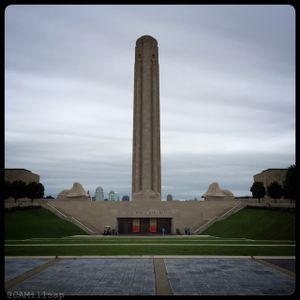Travel: Kansas City’s National WWI Museum and Memorial
The young woman, probably in her late teens or early 20s, stepped up to the small window cut into the wall of the exhibit and peered in. The scene—showing the rough interior of a WWI British trench—was bathed in eerie blue light. Inside, two soldiers—Tommies—sheltered by row upon row of stacked sandbags, faced the forest beyond, a world only barely visible though a wall of twisted barbed wire.
She turned to the young man standing beside her. “Did we study this?” she asked, a puzzled look on her face.
“I think so,” he replied. “I’m pretty sure we did.”
The pair put their faces back to the opening in the wall and studied the scene for a few minutes before walking on.
Welcome to the the other world war. The first one. The war that was to have ended all wars and did not. The war we haven’t studied enough.
This is what brought me to Kansas City, Missouri. The National WWI Museum and Memorial is the only one of its kind in the nation. It is the repository of stories, photos, artifacts and ephemera of the era and I have been researching the stories of the men and women who served in the Great War, some involved for years before the United States officially entered.
The story of the memorial and museum that followed is almost as epic as the war it commemorates. Just two weeks after the Armistice that ended hostilities on November 11, 1918, after the loss of 17 million lives and the destruction of an entire generation in Europe, Kansas City decided to build a monument to commemorate those who served and those who died in the war. Less than two weeks later city leaders and residents had raised more than $2,5 million to build what would be known as the Liberty Memorial and it was dedicated on November 11, 1926,
You enter the National World War I Museum, constructed beneath the memorial in 2006, by descending a set of stone steps. Once inside, you must cross a glass bridge over a field of poppies to enter the main galleries. Each of the 9,000 flowers represents 1,000 combatant deaths.
The Museum’s exhibits are comprehensive and bring to life both the monumental and cruel aspects of the war. Interactive media displays include music of the period and powerful war poetry. Larger pieces include a restored ambulance, once manned by American volunteers working with the French army, a 1917 Harley Davidson army motorcycle and a French tank.
History, the most powerful educator, can’t teach us if we don’t study it. The United States came late to the effort, and our losses were small when compared to those of the other allies, but the chain of events triggered by the First World War still touch our lives today.
In 2017 the country will mark the centennial of America’s entry into the war. Most of us, if we look, can find at least one ancestor who served.
As I gathered my things to leave, I passed a family with three young children. Their father was reading from a poster asking Americans to eat less so that soldiers “over there” would have enough. He had the children’s attention. In their short lives no one had ever asked them to do without food. He led them on to the display on the African American soldiers who fought abroad for a democracy that gave them short shrift at home.
The oldest child, a boy, stepped close to the glass. I watched him study the words and the photos and it occurred to me that in a few years he will be old enough to go to war, if another war should come. If past mistakes should be made again.
Shaking the thought from my mind, I picked up my bag and walked out into the soft Missouri rain with a quote from Harry Truman, the man who made the decision that ushered in the nuclear age when he ended the Second World War, running through my head:
“There is nothing new in this world except the history we don't know.”
